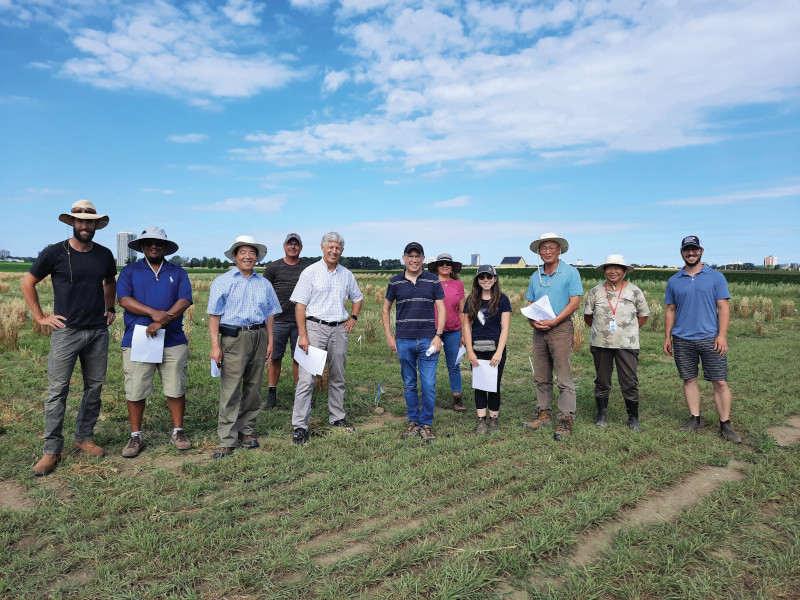Agriculture and Agri-Food Canada’s scientific capacity today is not less than it was prior to 2000, François Eudes says. What’s really changed is the speed of technology.
François Eudes wears two hats, and both are important in guiding the direction that Agriculture and Agri-Food Canada (AAFC) is heading in terms of its plant science and breeding research.
First hat: Eudes serves as director research, development and technology of the Science and Technology Branch at AAFC (a role he’s held since 2015) for sites located in Alberta. He oversees a large group of staff in two research and development centres (Lethbridge and Lacombe) and two satellite research farms (Beaverlodge and Vauxhall), and manages the resources associated with their science programs.
Second hat: he’s the national AAFC science lead for the breeding innovation and crop germplasm development portfolio, which captures AAFC’s science capacity related to breeding.
With a background in plant biology and breeding innovation, Eudes has been a pivotal figure in driving AAFC’s scientific agenda since joining the management team nearly a decade ago.
It’s an agenda undergoing major changes, not the least of which is AAFC’s foray into biotechnology, and the resulting effect that vision has had on AAFC itself.
“AAFC is heavily invested in cutting-edge fields such as genomics, proteomics and crop genetics. These scientific disciplines are crucial for advancing breeding techniques and improving crop yields,” he says.
“Our vision is significantly impacted by how science is conducted and how organizations like AAFC deliver and fund research. Over the decades, our focus has shifted to include emerging fields such as nanotechnology and quantum physics, which were unimaginable in agricultural contexts 40 years ago.”
Eudes’ journey from a research scientist to a management role reflects the evolving nature of agricultural research, where the integration of diverse scientific expertise is essential for success.
Eudes, who grew up in France and did his studies in Quebec, emphasizes that the evolution of AAFC’s priorities over the years reflects broader changes in the scientific landscape.
This shift means that while there may be fewer lead scientists at AAFC today, those in place are better resourced and supported, he says, adding that AAFC encourages transformative approaches and fosters greater collaboration, both internally and externally.
Public and Private Sector Synergy

The integration of public and private efforts is crucial, especially in areas where private investment is limited, according to Henry de Gooijer, one of Eudes’ AAFC colleagues and an advisor on science partnerships.
AAFC scientists and breeders are world-class, always seeking innovation and change. However, as technology evolves and new tools become available, AAFC needs to figure out how to adopt these advancements to remain efficient and competitive on a global scale, he says.
De Gooijer has worked with Eudes for years and believes the vision his friend and co-worker has brought to AAFC’s research agenda is helping AAFC be more efficient, nimble and effective.
“Some parts of the sector might think we’re not changing fast enough, while others might wonder why we need to change when the current system works,” de Gooijer says.
“Maintaining our capacity in a changing world is crucial, just like a producer who updates their seeding system. If they hadn’t changed over the past 30 or 40 years, they wouldn’t be as advanced as they are today.”
It’s not just about maintaining AAFC’s position but also about meeting the sector’s expectations and being able to grow, de Gooijer says. Recent staffing initiatives have brought in new scientists specializing in phenomics and genomics, areas vital for improving crop screening and breeding efficiency.
“In my experience with François, he brings a solid grasp of the opportunities these technologies present and also has a realistic view of the challenges in implementing them,” de Gooijer adds.
“Another one of his great attributes is that he’s not afraid to push for change — not recklessly, but with a clear sense of purpose. He understands the need to take brave steps to introduce new technology.”
It’s easier to understand the evolution of agricultural science if we look back over several decades, Eudes says. First, it’s important to consider how the science itself has evolved, and then how organizations like AAFC deliver and fund research. This evolution is gradual and becomes clearer when viewed over a long period.
“In terms of plant biology, AAFC’s scientific capacity today is not less than it was before 2000. We may have fewer lead scientists, but we resource them better. We encourage creativity and transformative approaches, and we foster greater collaboration both internally and externally. Our role goes beyond just performing science; it involves ensuring that our innovations reach the market and benefit the agricultural sector,” Eudes says.
Breeders at AAFC, for instance, have taken steps beyond simply releasing registered products. These products are now offered through competitive processes to entities that can bring them to market, he notes.
“Our goal is to help not just AAFC scientists but also those in academia and the private sector succeed. This collaboration is crucial, especially in Canada, where the contribution from small and medium-sized enterprises is smaller compared to the EU or the U.S.,” he adds.
“For hybrid crops like canola, corn and soybean, multinationals dominate the market because of the control over return on investment. However, for perennial forage crops, it’s different, with no private companies developing new generations of these crops in Canada. This work is left to the public sector, including our breeding programs and our collaboration with the University of Saskatchewan.”
Between these extremes, different crops fall at various points in the breeding continuum, he notes.
“AAFC’s role is to generate science and innovation that support a diverse ecosystem of plant species. This ecosystem’s success relies on understanding the nature of each plant species and the market associated with it,” he adds.
“Our goal isn’t just to generate knowledge but to ensure its application, bridging the gap between scientific innovation and impactful commercialization.”












